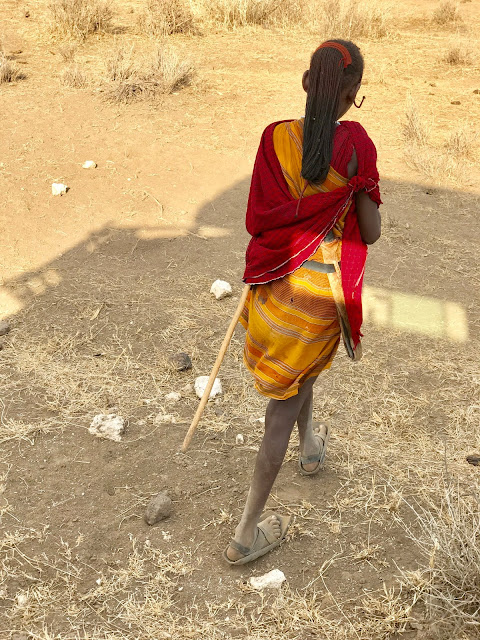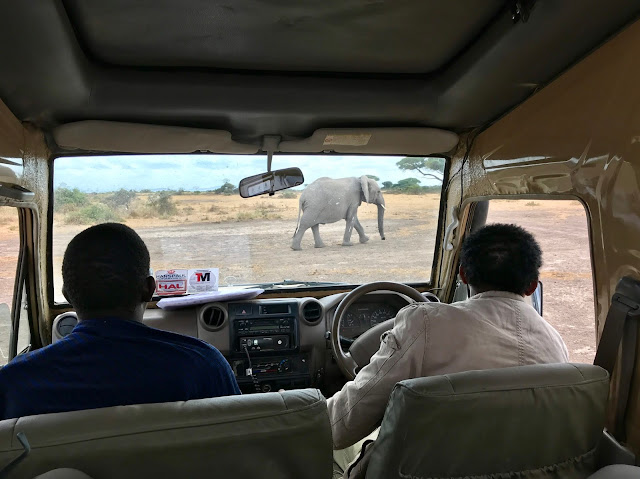Not all of the animals we saw on our twice daily game drives were the wild kind. In fact, counting numbers alone, we saw many more domestic cows, sheep and goats than elephants, zebras and giraffes. That's because we were in the land of the Maasai tribes who are traditionally nomadic herders.
Nowadays, the Maasai are semi-nomadic, with the women and children staying put in the villages
while the men and young warriors tend the cow, sheep and goat herds across the savanna.
We first saw their brightly colored clothing from a distance as we drove from the airport to the hills area; but once we got off the main road, their regular presence became part of the landscape. In fact, the youngest Maasai herders often heard or saw our vehicles sooner than we saw them and would come running from the bush shouting as we passed by.
Were they looking for food? Water? Money? As a rule we never stopped, except this one time.
Our driver/guide gave the young man a bottle of water which he appeared to appreciate.
As this young man turned to go back to his herd of goats, I could see his long, braided hair. Unlike most Western cultures where girls and women have long hair, his hair is typically Maasai. It reveals that he is a young male warrior and his long hair and shiny metal adornments, as seen in the previous photo, are designed to attract women. On the other hand, young girls and boys along with older men all shave their heads while grown married women keep their hair covered only to be seen by their husbands.
More Animals
Only in retrospect am I able to articulate the difference between seeing the animals in the hills region of northern Tanzania with our experiences later in the Serengeti, Tanganire National Park, and the Ngorongoro crater. And this photo succinctly captures two of the biggest differences--
proximity and exclusivity.
Because vehicles are allowed to drive off road, we were able to get very close to the animals for viewing and taking pictures. In fact, often I was able to use my iPhone7+ to capture the scene (like this photo) rather than my Canon Powershot SX60 HS. I also like this photo because it shows the context of our game drives with one of our two Land Cruisers peeking out from behind a bush.
As for exclusivity, except for one time, we were the only vehicles out looking for game unlike elsewhere where we were among dozens of safari vehicles.
 |
| A group of giraffe is called a ‘tower’ of giraffe, as their heads can often be seen sticking high above the trees on the horizon. |
 |
| Notice how well this giraffe's coloring and pattern mimic its habitat. |
 |
| By off-roading, we were able to follow animal trails along with the keen knowledge of our Trip Leader and driver/guide to look for animals on our game drives. |
While I have many better photos of elephants, the following pictures show how close we could get to them.
All the elephants we observed tended to browse, which means they moved slowly through an area while they ate.
And we experienced no threatening or active encounters with any elephant groups.
Instead, we were able to quietly watch them walk, rub up against trees, strip leaves from trees and shrubs,
while simultaneously monitoring their babies' whereabouts.
 |
| A group of elephants is called a ‘memory’ of elephants. This is in reference to their strong family ties, intelligence, and reputedly long memories. |
 |
| Seeing animal butts is very common as they tend to walk away as we would approach. But don't you just love the crossed-leg stance of the young elephant on the left? |
Interestingly, this was one of the few other vehicles we saw while on our game drives in the Mount Kilimanjaro savanna region.
It had become stuck in a badger hole and needed the help of one of our drivers to get out.
Later, with no real roads to follow, our driver/guides took us to the border between Tanzania and Kenya. How they could find their way in this vastness with no apparent landmarks or GPS devices attests to their skill and deep knowledge of the area.
The border between the two countries appears as an unofficial, invisible line in the savanna, but shortly after we arrived, the Kenyan border patrol arrived on his motorbike to check us out. Here, he and our driver/guide Salum exchange pleasantries and whatever. Apparently, Tanzania is much more laissez-faire than Kenya with who crosses this border, where and when.
While we were able to take pictures at this official border marker, we would not have been allowed to walk or drive much further into Kenya on our own. This difference in attitudes makes for some antagonistic relations between the two neighboring countries.
 |
| A group of humans is called a crowd, a tribe, a clan, a gang, a mob, a community . . . depending upon its size. |
What must be Ronjo's thoughts as he scans the landscape of his homeland?
The history of the Maasai is similar to that of Native Americans in that the government
has moved them from their native lands and not fulfilled all the promises they made.
But I'll address that in a later blog.
 |
| A group of zebra is called a ‘dazzle’ perhaps because zebra are one of the most strikingly beautiful animals in the African bush. |
 |
| The term for a group of wildebeest (also known as gnu) is a ‘confusion’ of wildebeest. This probably originates from the noise and confusion that happens in large migratory movements of wildebeest. |
 |
| This is one of many Ostriches which we saw both here and in the Serengeti. They are relatively easy to spot in the distance because they are so big. |
A little-known fact is that vultures belong to the fastest declining group of birds in the world. Most of the vultures are being poisoned by poachers who put the poison in dead carcasses. One poisoned carcass can kill up to a 100 birds. Poachers know that soaring vultures in the sky can alert game rangers to their whereabouts. So they poison the vultures which allows them to do their illegal business without being watched.
 |
| We saw plenty of these pretty turquoise birds, and I was even able to capture this photo. But I can't remember what it is. (EDIT: According to a reader, it is a lilac breasted roller. Asante) |
On our last full day in the hills region, we celebrated a successful pre-trip and the beauty of a Tanzanian sunset with a cocktail party in the bush. Even though we never experienced that iconic view of Mount Kilimanjaro, the animals we did see and the people we met made up for it and left long-lasting impressions and memories.
 |
| In this east-looking view you can just see the lights of our tented camp, Kambi Ya Tembo. |
Maisha mareful! Cheers!
References:
https://africageographic.com/blog/best-collective-nouns-animals-safari/
https://www.tanzania-experience.com/blog/vultures-efficient-cleaners/
https://greenglobaltravel.com/maasai-culture-tanzania/
https://www.zegrahm.com/blog/maasai-culture-history-understanding-soul-east-africa


























Susan, the bird you asked about is a Lilac Breasted Roller. One of my favorites.
ReplyDeleteThank you! I am not much of a birder other than to appreciate their colors and form. We saw lots of these.
Delete